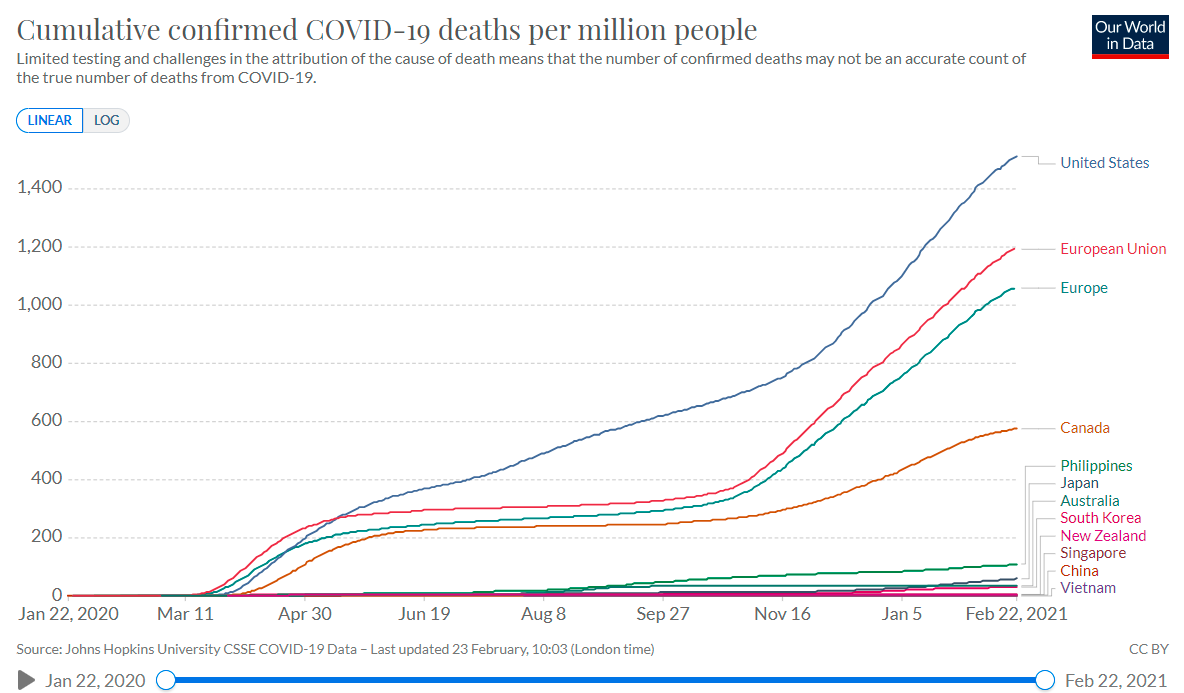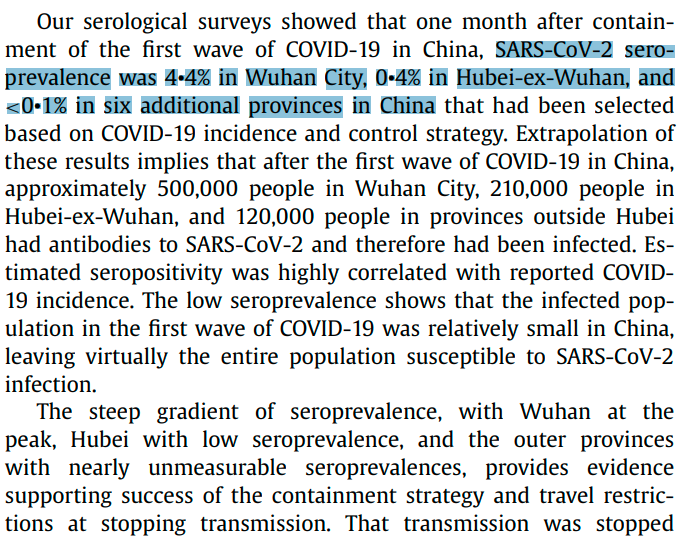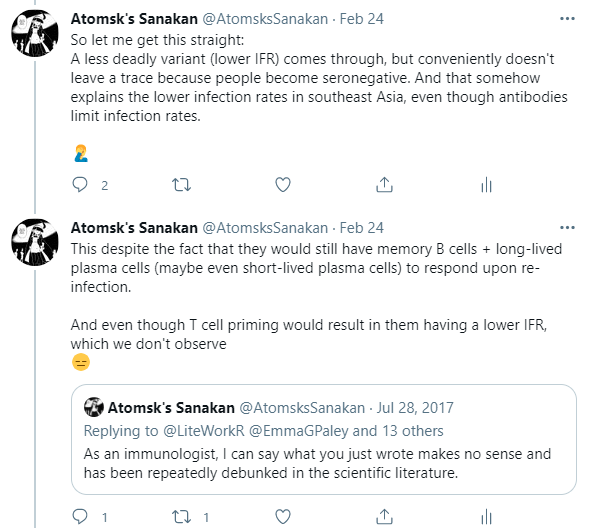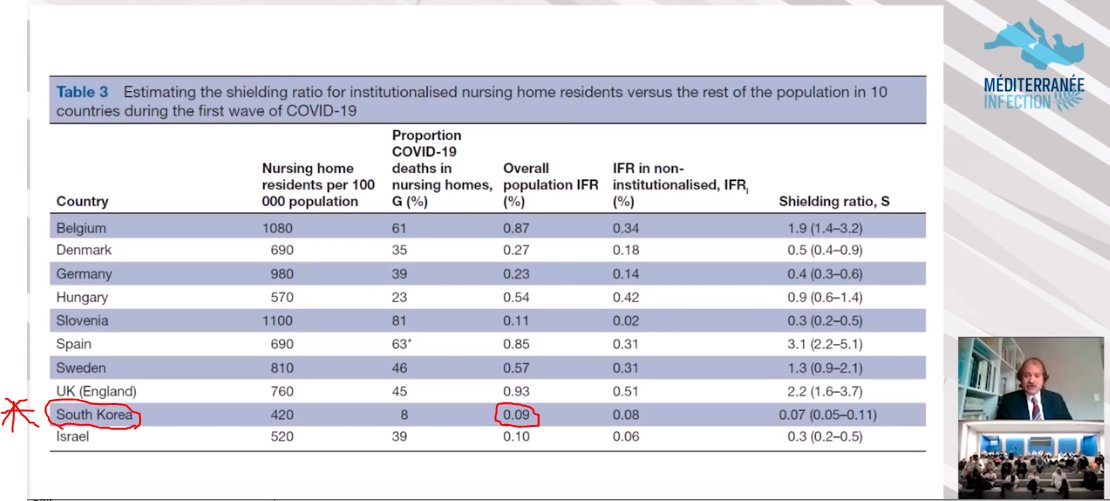1/E
Various southeast Asian nations suffered relatively few COVID-19 deaths per capita, especially in comparison to many "western" nations.
There's been a lot of speculation on why this is.
So this thread will examine some possible explanations.
archive.is/FkAho
Various southeast Asian nations suffered relatively few COVID-19 deaths per capita, especially in comparison to many "western" nations.
There's been a lot of speculation on why this is.
So this thread will examine some possible explanations.
archive.is/FkAho

2/E
There are at least 3 types of explanation for what's occurring in various southeast Asian countries:
1) insufficient testing that misses many infections and/or misses many COVID-19 deaths
2) lower number of infections
3) lower proportion of infected people die of COVID-19
There are at least 3 types of explanation for what's occurring in various southeast Asian countries:
1) insufficient testing that misses many infections and/or misses many COVID-19 deaths
2) lower number of infections
3) lower proportion of infected people die of COVID-19
3/E
For explanation 1:
It's unlikely their testing misses more deaths, since their excess deaths don't outpace their reported COVID-19 deaths more than in many 'western' countries.
nytimes.com/interactive/20…
bbc.com/news/world-530…
economist.com/graphic-detail…
ncbi.nlm.nih.gov/pmc/articles/P…



For explanation 1:
It's unlikely their testing misses more deaths, since their excess deaths don't outpace their reported COVID-19 deaths more than in many 'western' countries.
nytimes.com/interactive/20…
bbc.com/news/world-530…
economist.com/graphic-detail…
ncbi.nlm.nih.gov/pmc/articles/P…




4/E
Insufficient PCR testing, or antigen testing, early on might still miss past infections. Antibody testing addresses that; this will be discussed more a bit later.
archive.is/sjUkT
Insufficient PCR testing, or antigen testing, early on might still miss past infections. Antibody testing addresses that; this will be discussed more a bit later.
https://twitter.com/AtomsksSanakan/status/1347304761415135232
archive.is/sjUkT

5/E
For explanation #3:
IFR (infection fatality rate) is the proportion of SARS-CoV-2-infected people who die of COVID-19. So explanation #3 states IFR is lower in southeast Asian nations.
Some proposed reasons for why this could be:

For explanation #3:
IFR (infection fatality rate) is the proportion of SARS-CoV-2-infected people who die of COVID-19. So explanation #3 states IFR is lower in southeast Asian nations.
Some proposed reasons for why this could be:
https://twitter.com/AskeladdenTX/status/1309633580008644609

6/E
The co-morbidities explanation seems less plausible, since IFR is driven more by age and sex than by co-morbidities.
IFR increases with age, as do co-morbidities, while the rate of various co-morbidities differs by sex.
link.springer.com/article/10.100…
The co-morbidities explanation seems less plausible, since IFR is driven more by age and sex than by co-morbidities.
IFR increases with age, as do co-morbidities, while the rate of various co-morbidities differs by sex.
link.springer.com/article/10.100…

7/E
South Korea + Japan are useful test cases here, since they have relatively old populations with less obesity than in many "western" nations.
So explanation #3 would predict those 2 nations to have lower IFRs.
populationpyramid.net/world/2019/
ourworldindata.org/obesity
South Korea + Japan are useful test cases here, since they have relatively old populations with less obesity than in many "western" nations.
So explanation #3 would predict those 2 nations to have lower IFRs.
populationpyramid.net/world/2019/
ourworldindata.org/obesity

8/E
Yet South Korea's IFR is comparable to western nations in spring/summer, regardless of whether one uses antibody testing or PCR-based modeling to estimate the number of infections.
[~0.6% August IFR: arxiv.org/pdf/2101.11991…]
link.springer.com/article/10.100…
Yet South Korea's IFR is comparable to western nations in spring/summer, regardless of whether one uses antibody testing or PCR-based modeling to estimate the number of infections.
[~0.6% August IFR: arxiv.org/pdf/2101.11991…]
https://twitter.com/AtomsksSanakan/status/1312562674656522240
link.springer.com/article/10.100…

9/E
Japan's IFR is on the higher-end of what's seen in western nations.
[
[with: wwwnc.cdc.gov/eid/article/27…]
And China's IFR is comparable to that of western nations.
thelancet.com/journals/lanmi…
[with: thelancet.com/journals/lanwp…]
Japan's IFR is on the higher-end of what's seen in western nations.
[
https://twitter.com/AtomsksSanakan/status/1343866026879053824]
https://twitter.com/AtomsksSanakan/status/1327772908819779584
[with: wwwnc.cdc.gov/eid/article/27…]
And China's IFR is comparable to that of western nations.
thelancet.com/journals/lanmi…
[with: thelancet.com/journals/lanwp…]

10/E
So explanation #3 is likely false.
That leaves explanation #2:
As per part 4/E, antibody testing on representative samples allows one to determine the number of infected people, without the limitations of PCR + antigen testing from explanation #1
So explanation #3 is likely false.
That leaves explanation #2:
As per part 4/E, antibody testing on representative samples allows one to determine the number of infected people, without the limitations of PCR + antigen testing from explanation #1
https://twitter.com/AtomsksSanakan/status/1341185258964836353
11/E
Japan's antibody-based infection rates were ~1% or less
onlinelibrary.wiley.com/doi/full/10.10…
mhlw.go.jp/stf/seisakunit…
fukushihoken.metro.tokyo.lg.jp/iryo/kansen/ko…
pref.osaka.lg.jp/hodo/index.php…
pref.miyagi.jp/uploaded/attac…
pref.aichi.jp/site/covid19-a…
pref.fukuoka.lg.jp/press-release/…
pref.hiroshima.lg.jp/site/2019-ncov…
wwwnc.cdc.gov/eid/article/27…
Japan's antibody-based infection rates were ~1% or less
onlinelibrary.wiley.com/doi/full/10.10…
mhlw.go.jp/stf/seisakunit…
fukushihoken.metro.tokyo.lg.jp/iryo/kansen/ko…
pref.osaka.lg.jp/hodo/index.php…
pref.miyagi.jp/uploaded/attac…
pref.aichi.jp/site/covid19-a…
pref.fukuoka.lg.jp/press-release/…
pref.hiroshima.lg.jp/site/2019-ncov…
wwwnc.cdc.gov/eid/article/27…

12/E
Low antibody-based infection rates (i.e. seroprevalence) continued into autumn 2020 in Japan, as per 11/E, + in South Korea:
arxiv.org/abs/2101.11991
China's seroprevalence was highest in Wuhan in spring, and <1% elsewhere:
clinicalmicrobiologyandinfection.com/article/S1198-…
thelancet.com/journals/lanwp…
Low antibody-based infection rates (i.e. seroprevalence) continued into autumn 2020 in Japan, as per 11/E, + in South Korea:
arxiv.org/abs/2101.11991
China's seroprevalence was highest in Wuhan in spring, and <1% elsewhere:
clinicalmicrobiologyandinfection.com/article/S1198-…
thelancet.com/journals/lanwp…

13/E
Western nations had much higher infection rates, with their hardest-hit regions often having rates 1 or 2 orders of magnitude more than in the three southeast Asian nations noted before
istat.it/it/files//2020…
[mscbs.gob.es/gabinetePrensa…]
portalcne.isciii.es/enecovid19/inf…
Western nations had much higher infection rates, with their hardest-hit regions often having rates 1 or 2 orders of magnitude more than in the three southeast Asian nations noted before
istat.it/it/files//2020…
[mscbs.gob.es/gabinetePrensa…]
portalcne.isciii.es/enecovid19/inf…

14/E
So explanation #2 is most likely correct.
ukbiobank.ac.uk/media/x0nd5sul…
amjmed.com/article/S0002-…
medrxiv.org/content/10.110…
uoflnews.com/post/uofltoday…
medrxiv.org/content/10.110…
medrxiv.org/content/10.110…
[medrxiv.org/content/10.110…
thelancet.com/journals/lanin…]
corona-immunitas.ch/en/
So explanation #2 is most likely correct.
ukbiobank.ac.uk/media/x0nd5sul…
amjmed.com/article/S0002-…
medrxiv.org/content/10.110…
uoflnews.com/post/uofltoday…
medrxiv.org/content/10.110…
medrxiv.org/content/10.110…
[medrxiv.org/content/10.110…
thelancet.com/journals/lanin…]
corona-immunitas.ch/en/

15/E
It's unlikely that prior infection with other coronaviruses explains this (see part 5/E), since:
- innate immunity does not improve substantially
- T cells do not primarily limit infections, beyond impacting on B cells

It's unlikely that prior infection with other coronaviruses explains this (see part 5/E), since:
- innate immunity does not improve substantially
- T cells do not primarily limit infections, beyond impacting on B cells
https://twitter.com/profshanecrotty/status/1309170532965920769
https://twitter.com/AtomsksSanakan/status/1309311345947484166

16/E
Similarly, this likely is not explained by cross-reactive B cells, plasma cells, and/or antibodies from prior infection with other coronaviruses.
nature.com/articles/s4159…
medrxiv.org/content/10.110…
medrxiv.org/content/10.110…
Similarly, this likely is not explained by cross-reactive B cells, plasma cells, and/or antibodies from prior infection with other coronaviruses.
https://twitter.com/AtomsksSanakan/status/1312654302742183936
https://twitter.com/AtomsksSanakan/status/891040491214688257
nature.com/articles/s4159…
medrxiv.org/content/10.110…
medrxiv.org/content/10.110…

17/E
Many of those offering these alternative explanations do so for ideological reasons and/or in bad faith, because they want to avoid an obvious answer:
Policies + behaviors in southeast Asia limited infections
20:42 - 25:52 :
Many of those offering these alternative explanations do so for ideological reasons and/or in bad faith, because they want to avoid an obvious answer:
Policies + behaviors in southeast Asia limited infections
20:42 - 25:52 :
18/E
So instead of making excuses about how southeast Asian nations have special exposure to other coronaviruses, or better immune systems, or..., we in western nations should own up to the reality that their policies + practices worked.
Deal with it.🤷♂️

So instead of making excuses about how southeast Asian nations have special exposure to other coronaviruses, or better immune systems, or..., we in western nations should own up to the reality that their policies + practices worked.
Deal with it.🤷♂️
https://twitter.com/AtomsksSanakan/status/1325442309668921351

19/E
And h/t to @KawasakiKR11 for help in finding seroprevalence studies for Japan in part 11/E, since I only read and write in English.
And h/t to @KawasakiKR11 for help in finding seroprevalence studies for Japan in part 11/E, since I only read and write in English.
https://twitter.com/AtomsksSanakan/status/1364470684949299203
20/E
Sources on infection-limiting strategies in southeast Asia:
(act early:
link.springer.com/article/10.100…
academic.oup.com/cid/article/71…)
web.archive.org/web/2021022418…
journals.sagepub.com/doi/full/10.11…
ncbi.nlm.nih.gov/pmc/articles/P…
thelancet.com/article/S0140-…
ncbi.nlm.nih.gov/pmc/articles/P…
Sources on infection-limiting strategies in southeast Asia:
(act early:
link.springer.com/article/10.100…
academic.oup.com/cid/article/71…)
https://twitter.com/AtomsksSanakan/status/1364599742257364995
web.archive.org/web/2021022418…
journals.sagepub.com/doi/full/10.11…
ncbi.nlm.nih.gov/pmc/articles/P…
thelancet.com/article/S0140-…
ncbi.nlm.nih.gov/pmc/articles/P…

21/E
Examples of what I critiqued from those using a Tokyo study w/ non-representative sampling [
Nic Lewis:
judithcurry.com/2020/10/14/t-c…
Examples of what I critiqued from those using a Tokyo study w/ non-representative sampling [
https://www.twitter.com/AtomsksSanakan/status/1365177417023774720]:
https://www.twitter.com/carlheneghan/status/1309558504307544064
https://www.twitter.com/MonicaGandhi9/status/1335747616148127745
https://www.twitter.com/dwallacewells/status/1308855749821554689
https://www.twitter.com/AlexBerenson/status/1308798932097658881
https://www.twitter.com/MLevitt_NP2013/status/1308979101215096834
Nic Lewis:
judithcurry.com/2020/10/14/t-c…

22/E
Further context on why prior infection with other coronaviruses does not adequately explain low COVID-19 deaths per capita in southeast Asian countries, especially in light of low seroprevalence:

Further context on why prior infection with other coronaviruses does not adequately explain low COVID-19 deaths per capita in southeast Asian countries, especially in light of low seroprevalence:
https://twitter.com/AtomsksSanakan/status/1364660714342932487
https://twitter.com/AtomsksSanakan/status/1364664008830246913
https://twitter.com/AtomsksSanakan/status/1365870324861067266

23/E
Below John Ioannidis defends a failed version of explanation #3 in February 2021. He under-estimated IFR in southeast Asia, as covered in parts 8/E + 9/E, along with other threads.
3:03 and 16:05 :

Below John Ioannidis defends a failed version of explanation #3 in February 2021. He under-estimated IFR in southeast Asia, as covered in parts 8/E + 9/E, along with other threads.
https://twitter.com/AtomsksSanakan/status/1369420295187144709
https://twitter.com/AtomsksSanakan/status/1341286778884550656
3:03 and 16:05 :

24/E
Re: "Ioannidis defends a failed version of explanation #3 [...]. He under-estimated IFR in southeast Asia"
Update on Asian seroprevalence studies:
thelancet.com/journals/lance…
mhlw.go.jp/content/000761…
He's still doing it:

Re: "Ioannidis defends a failed version of explanation #3 [...]. He under-estimated IFR in southeast Asia"
Update on Asian seroprevalence studies:
thelancet.com/journals/lance…
mhlw.go.jp/content/000761…
https://twitter.com/KawasakiKR11/status/1379530595148181507
He's still doing it:
https://twitter.com/AtomsksSanakan/status/1376029923903672322

25/E
Ioannidis, March 2021:
"I'm not talking about [New Zealand, Vietnam, Taiwan] that did a wonderful job and did exactly what I was saying a year ago. Test, test, test. That's what the WHO was saying. And then isolate, then contact trace"
31:35 - 31:47
Ioannidis, March 2021:
"I'm not talking about [New Zealand, Vietnam, Taiwan] that did a wonderful job and did exactly what I was saying a year ago. Test, test, test. That's what the WHO was saying. And then isolate, then contact trace"
31:35 - 31:47
26/E
Basic summary of the thread:
Southeast Asian countries successfully limited COVID-19 deaths predominately by pursuing policies + behaviors that prevented infections.
It's not a matter of them having better immune systems, special pre-exposure to other viruses, etc.
Basic summary of the thread:
Southeast Asian countries successfully limited COVID-19 deaths predominately by pursuing policies + behaviors that prevented infections.
It's not a matter of them having better immune systems, special pre-exposure to other viruses, etc.
27/E
Based on this thread, one would predict that Malaysia's NHMS results (likely to be released in May/June) would show <2% of people infected, with an IFR of ≥0.4%.
iku.moh.gov.my/nhms
ourworldindata.org/explorers/coro…
Based on this thread, one would predict that Malaysia's NHMS results (likely to be released in May/June) would show <2% of people infected, with an IFR of ≥0.4%.
iku.moh.gov.my/nhms
https://twitter.com/AtomsksSanakan/status/1360114634662019073
ourworldindata.org/explorers/coro…

• • •
Missing some Tweet in this thread? You can try to
force a refresh




















